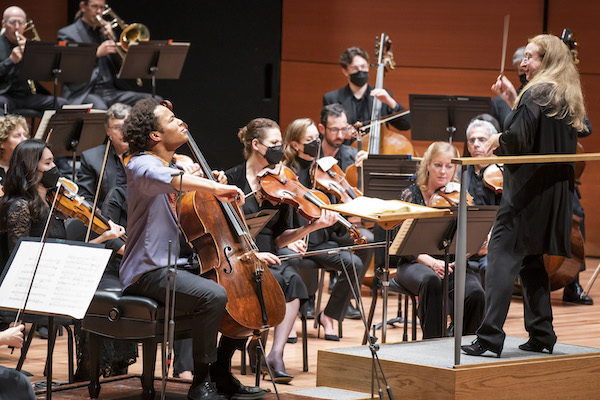Youthful cellist provides fleeting highlights in a rough night with Young, Philharmonic

For much of the New York Philharmonic’s concert Thursday night, Alice Tully Hall resembled a bay after a storm, as large vessels of the symphonic repertoire slipped their rhythmic moorings and drifted aimlessly.
Conductor Simone Young occasionally augmented her fluid conducting style with bouncing to indicate a beat, usually to little effect. The playing often suffered from ragged entrances, loose phrasing, and a lack of perceptible purpose other than to get loud and soft where the score indicated.
As these rhythmic Robin Hoods robbed from the long notes to give to the short, it took a sheriff from Nottingham to restore order. The young cellist Sheku Kanneh-Mason, who (thanks to playing at a royal wedding and two bestselling classical albums) has recently become that English town’s biggest non-fictional celebrity, put the ensemble on its mettle with a vigorous performance in Dvořák’s Cello Concerto in his Philharmonic debut.
The fog rolled back in after intermission, however. Even the resolute finale theme of Brahms’s First Symphony swam instead of marched.
The piece that fared best Thursday was the opener, Anton Webern’s arrangement for small orchestra of the Ricercar from J.S. Bach’s A Musical Offering. Originally composed more as an intellectual entertainment than as a piece to be performed, Bach’s intricate six-voice fugue unfolded at a steady walking pace, revealing at least some of its secrets through Webern’s slender yet kaleidoscopic orchestration. Muted brass and wheezy winds seemed to evoke the Baroque organs Bach himself played.
The Dvořák opened promisingly with a symphonic-style exposition and the soloist’s assertive entrance. Balance became a problem as horns stuck out of the orchestral texture, and the cellist’s sweet, woody tone was covered at times by horns or loud woodwinds. (Even the orchestral string sections, here and in the Brahms, were often overbalanced by their windy colleagues.) But in the cello’s lyrical second theme, Kanneh-Mason gave a much-needed seminar in playing with momentum and a long line.
Although the composer marked the second movement Adagio, ma non troppo, Thursday’s performance was troppo. As the tempo sagged, each bar of the music seemed to be starting over again, and winds went flat. At one point, during a sudden crescendo, one couldn’t tell what chords the horns thought they were playing. The cellist’s impassioned utterances were the bright spot in this movement.
Driven by a strutting march beat, the players pulled together in the concerto’s finale. The cellist’s playing was graceful, bold, and decorative by turns, and his orchestral support stayed mercifully in the background. His flying fingers wowed the listeners, and his give-and-take with conductor Young made for satisfying concerto action.
This upbeat finish brought enthusiastic applause, to which soloist and orchestra responded with a pre-arranged encore, the charmingly dancy Three-Minute Cello Concerto by Larissa Lakner, a participant in the Philharmonic’s Very Young Composer program.
The first movement of Brahms’s First Symphony displays the composer’s distinctive personality at its craggiest and most tender. On Thursday the crags were mostly missing, as the performance generated little tension during the anxious introduction or the urgent Allegro, and so there was little contrast with the more relaxed passages. Problems with balance and ensemble hindered the music’s momentum.
The Andante sostenuto posed fewer challenges of execution than the previous movement, and went better. Strings finally came out of hiding, delivering rich tone in dialogue with the plangent oboe. The horns were too loud when doubling the solo violin, and more so when in dialogue with it later.
In the gentle quasi-scherzo, Un poco Allegretto e grazioso, dotted rhythms went limp, making “graceful” difficult to achieve. As the tempo ratcheted higher, the woodwinds lagged behind.
The finale’s suspenseful introduction was distinguished by fine horn and flute solos. Although the famous march tune was out of focus, and sounded rushed at its later return, conductor Young finally asked for, and got, right-on marcato rhythms in the more assertive passages. She skillfully built Brahms’s long crescendos, and went into chugging overdrive for the exuberant coda, to the audience’s delight.
The program will be repeated 8 p.m. Friday and Saturday. nyphil.org; 212-875-5656.